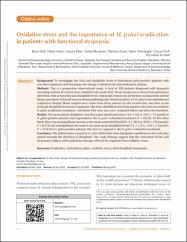Oxidative stress and the importance of H. pylori eradication in patients with functional dyspepsia

Göster/
Erişim
info:eu-repo/semantics/openAccessTarih
2022Yazar
Ebik, BeratAslan, Nihat
Ekin, Nazım
Bacaksız, Ferhat
Arpa, Medeni
Neşelioğlu, Salim
Erel, Özcan
Uçmak, Feyzullah
Üst veri
Tüm öğe kaydını gösterKünye
Ebik, B., Aslan, N., Ekin, N., Bacaksiz, F., Arpa, M., Neselioglu, S., Erel, O., & Ucmak, F. (2022). Oxidative stress and the importance of H. pylori eradication in patients with functional dyspepsia. Saudi journal of gastroenterology : official journal of the Saudi Gastroenterology Association, 28(6), 434–440. https://doi.org/10.4103/sjg.sjg_114_22Özet
Background: To investigage the thiol and disulphide levels in Helicobacter pylori-positive patients with
non-ulcer dyspepsia and investigate the change in these levels with eradication therapy.
Methods: This is a prospective observational study. A total of 320 patients diagnosed with dyspepsia
according to Rome IV criteria were included in the study. First, blood samples were drawn from patients to
determine their serum thiol and disulphide levels. Endoscopic biopsy was performed on all patients and the
biopsy specimens obtained were examined pathologically. Patients positive for H. pylori were administered
eradication therapy. Blood samples were drawn from these patients for the second time, and their serum
thiol and disulphide levels were measured. The thiol–disulfide levels of the patients who were successful in
H. pylori eradication treatment, with those who were not, were compared before and after the treatment.
Results: The mean plasma disulphide level decreased significantly from 14.0 ± 6.6 to 10.9 ± 5.9 µmol/L in
H. pylori-positive patients that responded to the H. pylori eradication treatment (P = 0.033). On the other
hand, there was an insignificant increase in the mean serum thiol level (341.4 ± 30.5 vs. 342.6 ± 29.8 µmol/L;
P = 0.273) and an insignificant decrease in the mean serum disulphide level (15.2 ± 2.5 vs. 14.8 ± 2.3 µmol/L;
P = 0.163) in H. pylori-positive patients that did not respond to the H. pylori eradication treatment.
Conclusion: The inflammation caused by H. pylori shifted the thiol–disulphide equilibrium in the cell redox
system towards the direction of disulphide. The study findings suggest that the restoration of the said
hemostatic balance with eradication therapy relieved the organism from oxidative stress.

















